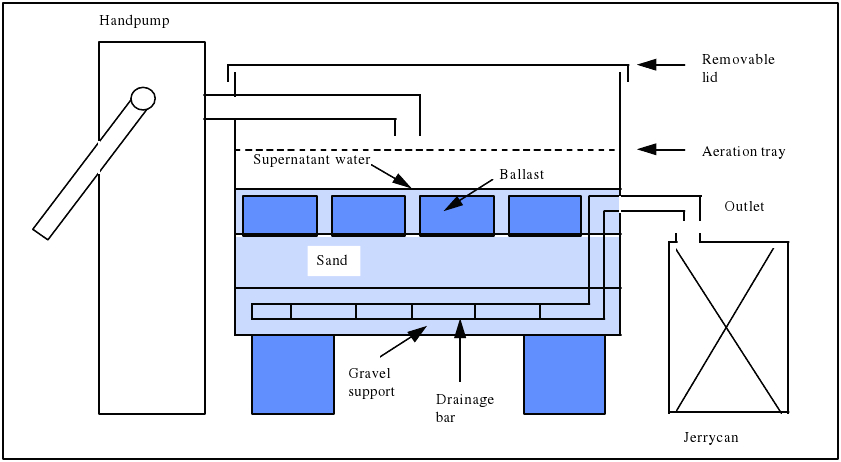Iron filter
IRF
The iron removal filter (IRF) is a cylinder built using ferrocement construction techniques. Inside, from top to bottom order, is a plastic basin full of charcoal, a layer of gravel, and an empty space for sedimentation. The water to be treated (in this model the water is assumed to be from a hand pump spout) first passes through the charcoal, aerating it, flows to the empty space at the bottom via a pipe where sedimentation of the precipitated iron takes place, then wells up through the gravel for filtration purposes. The finished water accumulates above the gravel filter, and this elevation enables users to draw it.
Biologically-enhanced method
Certain bacteria are capable of oxidising and immobilising iron. The bacteria responsible for the process appear to be natural inhabitants of the well environment and therefore, the microorganisms necessary to initiate the process are carried with the groundwater on to the filters. The active population of iron-oxidisers, which requires aeration in order to stimulate its growth, grows on the surface of the filter bed in the form of a slimy orange mat. It is within this zone of bacterial activity that the iron removal process appears to occur. Proponents of biological iron removal claim that this biologically-enhanced process is more efficient than the chemical process.
Construction, operations, and maintenance
IRF
To use it for the first time, the filter is filled with water and allowed to overflow a little. The first discharge is turbid from the gravel, but this clears up after a day or so of use. After placing their buckets under the tap, the users just pump the hand pump, and by gravity the water enters and flows
through the filter, displacing the previous treated contents, which then overflows thru the taps into their buckets.
With no moving parts, operation is mainly trouble free. Philippine Center for Water and Sanitation (PCWS) and the organizations has trained and constructed 80 IRFs already. So far, there have been no reports of any breakdown yet.
It is possible that the charcoal may eventually clog up. The basin can then be removed from the IRF and cleaned by running water through it, assisting the process by manual agitation of the charcoal chunks.
The gravel may also eventually clog up occasionally. Cleaning it is also by manual agitation while recycling water through the IRF. A bucket is placed under the open tap and the contents are led by pouring, dipper by dipper, back through the charcoal basin. In cases where deposits have built up in the sedimentation space, a drain can be opened to clean this out. The worst that can happen is that the unit may eventually need overhauling. All parts are then taken out and cleaned, and clogs and leaks repaired.
Biologically-enhanced method
Acknowledgements
- IRON REMOVAL FILTER. PHILIPPINE CENTER for WATER and SANITATION.


